

Bertrand Jubault sur Twitter : "@JeffDSachs #Agenda21 but by #P2P #netizens United not UN Control. Ethereum : the next generation cryptocurrency Platform? “Ethereum is to Bitcoin what a smartphone is to a calculator” Vitalik Buterin reveals Ethereum at Bitcoin Miami 2014 Ethereum Blog : A Brief History of Coin Crowdsales: Winners, Losers, and the Future of the Internet Like this: Like Loading...
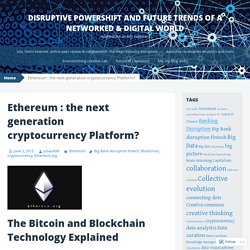
WORLD BOOKS - POLARITY, DIALECTIC, AND ORGANICITY. In the fall of 1925 Archie Bahm went off to Taylor University, an institution of higher education established by a conservative evangelical Protestant denomination, intending to prepare himself for the Christian ministry.

However, during the first semester he...abandoned his pre-ministerial plans, "to pursue my quest as a truth seeker. " That quest for truth absorbed him for the rest of his long life, and resulted in a rich and distinguished career as a university professor and philosopher. Extensive travels, publications which were translated into several Asian and European languages, and voluminous correspondence with fellow-philosophers on five continents served to put him in touch with philosophic thinking representing the major traditions globally. The beginning of this book traces the stages involved in working out the system which was to be known as "Organicism," and the various influences which were incorporated into its formulation.
Paper.pdf. ÐΞVgrants sur Twitter : "Please read our introduction carefully at Skype chat: Need writing help? Contact @MaryPDavies" Bertrand Jubault sur Twitter : "@oliviergoy @FinTechFR @lendix La finance decentralisee et sans Banques! Vite #p2p #decentralized #crowdcuration. Bertrand Jubault sur Twitter : "P2P : Disruptive Tidal wave of the digital economy #p2p #p2plending...
P2P Architecture : A disruptive tidal Wave. P2P means Peer to Peer Most People have heard or read this acronym but it seems very few people really grasp what it really mean’s, and the crucial role it’s playing in reshaping and disrupting the digital and wired information society we are living in.
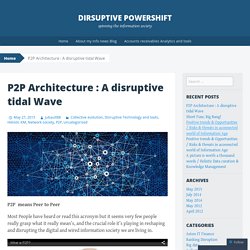
Most people are not aware, but the P2P Network technology has already played a KEY disruptive role in the Internet, is behind major game changing applications, has a bright future for the world! Therefore, understanding it’s TRUE nature is Very Important Napster was the first P2P network for file sharing. It allowed internet user to share and download files freely over the internet, which totally disrupted the music Copyright industry why was caught by surprised. It’s had a huge exponential growth, but it’s great idea was combined with an inborn defect, a Central registry, which made it vulnerable and was therefore shut down… 14th March 2000, release of GNUTELLA first ever open source decentralized file Sharing software.
P2P. Connective Knowledge. Connective Knowledge = A property of one entity must lead to or become a property of another entity in order for them to be considered connected; the knowledge that results from such connections is connective knowledge.
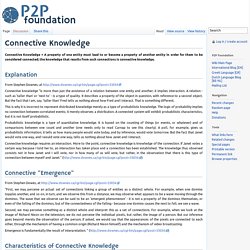
From Stephen Downes, at Connective knowledge "is more than just the existence of a relation between one entity and another; it implies interaction. A relation - such as 'taller than' or 'next to' - is a type of quality. It describes a property of the object in question, with reference to a second object. The Peer-To-Peer Revolution – 50+ Companies Changing The World. Peer-to-peer marketplaces are really booming right now.
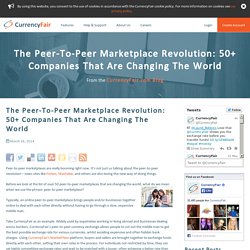
It’s not just us talking about the peer-to-peer revolution – news sites like Forbes, Mashable, and others are also loving this new way of doing things. Before we look at the list of over 50 peer-to-peer marketplaces that are changing the world, what do we mean when we use the phrase: peer-to-peer marketplace? Typically, an online peer-to-peer marketplace brings people and/or businesses together online to deal with each other directly without having to go through a slow, expensive middle man. Take CurrencyFair as an example. P2P revolution in 10 minutes. History of the Web. Sir Tim Berners-Lee invented the World Wide Web in 1989.
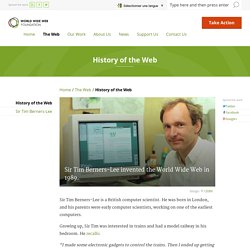
Sir Tim Berners-Lee is a British computer scientist. He was born in London, and his parents were early computer scientists, working on one of the earliest computers. Growing up, Sir Tim was interested in trains and had a model railway in his bedroom. Roger Clarke's 'P2P Research Agenda' P2P's Significance for eBusiness: Towards a Research Agenda Roger Clarke ** PrePrint of 30 April 2006 Published in the Journal of Theoretical and Applied Electronic Commerce Research 1, 3 (December 2006) 42 - 57, at © Xamax Consultancy Pty Ltd, 2005-06.
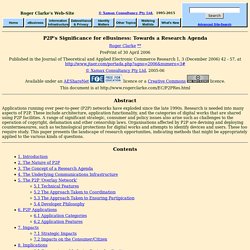
Xamax Consultancy Home-Page. Roger Clarke's 'P2P Research Agenda' P2P's Significance for eBusiness: Towards a Research Agenda Roger Clarke ** PrePrint of 30 April 2006.
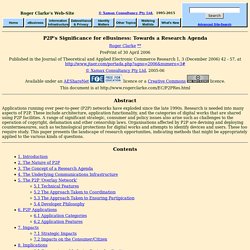
How Far Can the P2P Revolution Go? How far can the peer-to-peer revolution be pushed?

It’s time we start to speculate, because history is moving fast. We need to dislodge from our minds our embedded sense of what’s possible. Right now, we can experience a form of commercial relationship that was unknown just a decade ago. 43 Essential essays on the commons and Peer 2 Peer theory. This list is from the great P2P foundation website, which has loads of great articles and information on Peer 2 Peer (P2P) theory.
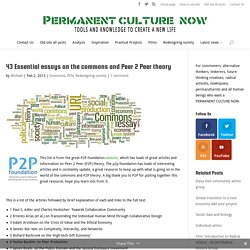
The p2p foundation has loads of interesting articles and is constantly update, a great resource to keep up with what is going on in the world of the commons and P2P theory. A big thank you to P2P for putting together this great resource, hope you learn lots from it. This is a list of the articles followed by brief explanation of each and links to the full text. 1 Paul S. Paul S. Roger Clarke's 'P2P Research Agenda' p2p networking. Peer-to-peer networking is not a new concept. Companies and universities have been utilizing architectures for more than 30 years in that would today be labeled as peer-to-peer.
In fact, the internet was originally developed in the late 1960’s to be a peer-to-peer system. The Original ARPANET connected UCLA, Stanford Research Institute, UC Santa Barbara and the University of Utah not in a client/server format but as equal computing peers. The early popular applications of the internet, FTP and Telnet, were themselves client/server applications but since every host on the Internet could FTP or Telnet to any other host, the usage patterns of the Internet were symmetric. In the early days of minicomputers and mainframes, the servers even acted as clients as well. In 1979 Usenet was developed by two Duke University graduate students and one from the University of North Carolina to exchange information in the Unix community. Around 15 years ago.